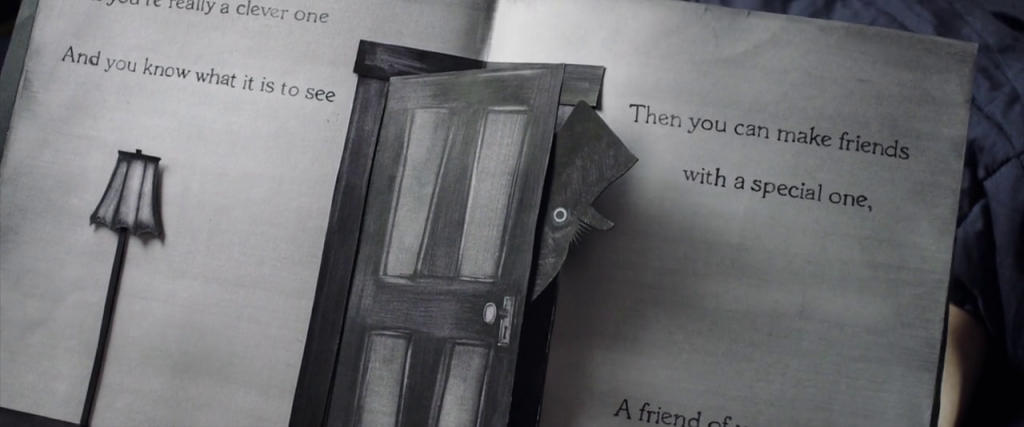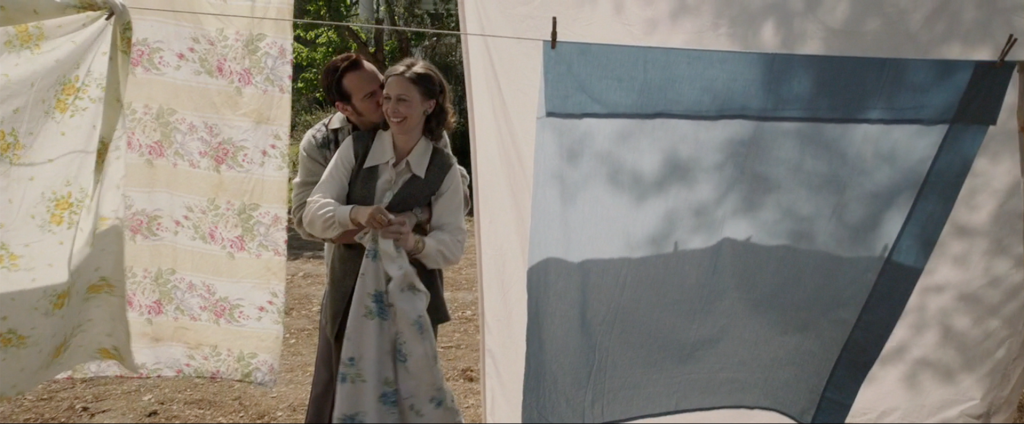Arguably, horror is a genre that often relies heavily on tropes. There’s a countless amount of bad horror movies out there which follow the a-z list of what a horror movie should contain, yet show little understanding of why those tropes are there in the first place. I’ve seen far too many horror movies where you can almost see the director thinking “yeah, this was really scary in that one movie so I’m going to do it here too!” while simultaneously demonstrating that they don’t have a clue as to why it was scary in the first place. A loud bang in itself is not scary. It might make you jump, but that’s just a physical reaction. It’s not true horror. Amidst all the offensively generic horror films, there are several that clearly prove why horror itself is such a unique genre. On a more general level, I find that good horror movies tend to play around with camera angles and creative shots more than other films, meaning that there are camera shots that feel uniquely suited to horror. Shots in horror movies are often used to create a sense of unease or even slight nausea, which is part of the reason they need to feel different from shots in other genres.
Yet horror movies are not just about creepy visuals. Certainly, that's one of my favorite aspects, but there’s a lot that goes into making an effective horror movie. To delve into this idea a bit deeper, I want to take a closer look at a very recent horror film called The Babadook. Let me be clear, this is not meant to be a review of the film. Instead, it’s more of a study of what makes it an effective horror film. As a result, there might be some very minor spoilers (though I’ll try to avoid giving too much away) but, if you’re like me, you might want to just go watch the film first, knowing as little as possible about it. In any case, I heartily recommend this film. There, that’s the review part out of the way. Let’s start analyzing!
The origin of the film already kind of sets it apart, because it’s written and directed by a woman, something that is still, unfortunately, fairly uncommon. Not only that, The Babadook is her feature-length debut, and it’s a wonderfully constructed one. Compared to something like Sam Raimi’s Evil Dead, a film that gleefully feels like a first-time director having a blast experimenting with the format, Jennifer Kent’s The Babadook is so tightly constructed that I was really surprised to hear it was a debut film. It exudes confidence and shows a deep understanding of how films, not only of the horror genre, work, and this comes through in several different ways.
To begin with, let’s just look at the title itself: The Babadook. It’s a title that for some might sound silly or even stupid, while for some it could be creepy or simply strange. In any case, it’s definitely mysterious, immediately creating the reaction of “what is a Babadook?” Now this is already important because it highlights one of the most crucial aspects of any horror film: mystery. Horror is all about creating tension, and there can be no tension if there is no mystery. At the same time, there can also be no tension if there is no foreshadowing, but I’ll come back to that point. In any case, The Babadook is a title that reveals very little about the film itself, but is, nevertheless, strangely captivating.
The mystery surrounding The Babadook is something that the film plays with throughout, while simultaneously understanding yet another key element of any effective horror movie: escalation. Many horror films, pardon my French, blow their wad way too early or way too often, foregoing any sense of tension in exchange for “LOOK AT THIS SCARY STUFF WE’RE SHOWING YOU!” Again, this tactic might make you jump every now and then, but it usually won’t create a feeling of absolute horror. To me, ‘horror’ is a feeling, rather than a reaction, and it’s impossible to create any lingering feelings, if a film has no understanding of tension or escalation.
Now, keep this theory of escalation in mind, as we look at how the Babadook character is actually utilized throughout the film. Mr. Babadook himself is introduced within the first 10 or so minutes of the film, although he doesn’t physically dominate the film from that point onwards (referring back to avoiding the idea of “blowing your wad” or, perhaps, “showing all your cards too early in the game"). Instead, the Babadook is peppered throughout the first half of the film, more as suggestions rather than overt appearances. As the film escalates, so too does the presence of The Babadook, but this is also in line with the character itself. This is where the concept of foreshadowing comes in, because the Babadook warns in the beginning, when it first appears as simply a stationary character in a children’s book, that the more you ignore it, the more vicious it will become. The tension then arises, because the audience knows to expect something, yet can’t predict exactly what will happen, bringing in the ‘mystery’ element of tension. Furthermore, as a result of all of this, the escalation is crucially tied to the character, which makes it all the more effective. Some films attempt to use escalation as a mechanic, yet it feels unnatural or unsuitable to the character itself. In this case, the horror comes not just from the pure technique of escalation, but from the feeling that The Babadook himself is escalating things. To put it more simply, it feels like the antagonist escalates things, rather than the director herself. This is crucial. The best films are those where the characters drive the plot, rather than the plot drives the characters.
As mentioned earlier, one of the key elements of tension is the idea of mystery. Throughout the film, there are moments where it’s not exactly clear what is ‘real’ and what isn’t. The ending itself is arguably open-ended as well. Once again, these are other crucial elements of horror movies: this feeling of uncertainty and the lack of proper closure. Not to say that the film doesn’t have an ending, but it leaves you feeling uneasy. Some films attempt to go for this open-ended feeling, but misunderstand it as not having an ending at all; in essence, they fail to actually create any sense of closure. The result there is that the audience just ends up thinking, why even watch a film if there’s no closure to everything that you’ve just spent the past 90 or so minutes watching. They're essentially anti-climactic, leaving the audience feeling cheated, and wondering about whether the director had any idea of why they even made the film in the first place. The Babadook knows how to walk that line between having an open ending and no ending at all. It certainly creates some sense of closure with the story and the characters, yet the little bit of closure it doesn’t give you serves to leave you with doubt, and doubt is an uneasy feeling. In a way, it ties into an idea that Steven Spielberg used on Jaws: he holds off on showing the shark too much, because he knows that the imagination is a powerful tool. If you can exploit a person’s imagination by showing them a little bit, but not everything, that’s how you really get them to experience horror. The Babadook’s ending gives you enough information for closure, but then also leaves room for your imagination to run wild, thinking about what could happen next. Great horror directors know that our brains can be such bastards sometimes.
Continuing this idea about ambiguity, through discussions of the films with others, I’ve found that there’s uncertainty about whether the Babadook is even real or not. Without giving too much away, there’s the psychology angle that questions the veracity of the Babadook, while a humanist angle might see the Babadook as real within the film world, yet acting as a metaphor for the psychological themes in the film.
Which brings me to my next point: the movie has themes. It’s not just about scares and the boogeyman. It’s about grief, mental and physical exhaustion, dealing with loss, the strains of being a single parent, the relationship between an only child and a single parent, suppression of memories and emotions, etc. These are themes that many people can relate to in at least some way. Perhaps not to all of them, but certainly to at least a few of them. Again, this is crucial because the themes make the characters and the reality of the world more relatable, and when horror is relatable, that’s when it’s truly terrifying.
Furthering this idea of relatable characters, The Babadook eschews from the tiring horror trope of characters behaving like idiots. Hands up if you’ve seen a horror film where you can’t help but facepalm at the idiocy of the characters. It’s a rather morbid feeling, yet there are some films, slasher films particularly, where a character dies, because they behave irrationally, and your only reaction is “well, you kind of deserved it.” It’s like the Darwin Awards, which rewards people that remove themselves from the human gene pool through their own stupidity. However, in The Babadook, there’s a distinct lack of frustration. Characters generally behave in a relatable way, attempting to handle situations on their own, before going to the authorities or other outside help. Predictably, yet understandably, the surreal nature of the situation makes it almost impossible for anyone to take them seriously. Towards the end, when characters actually start behaving in slightly irrational ways, it’s arguably due to the influence of the Babadook. That’s not me being an apologist for the film; it’s set up in the story and themes that this is the nature of the character.
Although this isn’t a review of the film, special mention must be made to the performances in the film, which are absolutely chilling. I can almost guarantee that they will make you feel something about the characters, whether it’s sympathy, empathy, hatred, disgust, etc. In all honesty, you’ll probably feel all of the above for the same character. Of course, these performances also add to the believability of the situation, and may even hit uncomfortably close to home for some viewers.
And this leads me to my final point. One of the reasons that The Babadook is such an effective horror film is because the horror doesn’t come solely from the oogie-boogie creature, but from the characters themselves. There’s already tension even before The Babadook is introduced, and that’s down to pretty much everything I’ve already listed above.
In short, The Babadook plays with reality, manipulates your emotions, escalates the tension, creates a sense of peril between the characters, and gets under your skin, because it feels relatable. Oh and the Babadook is also creepy as fuck!





